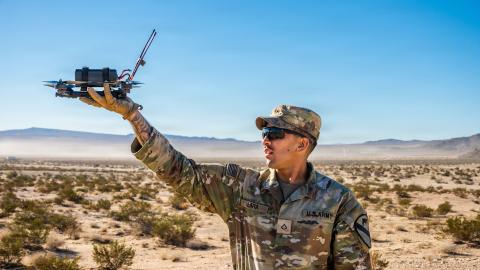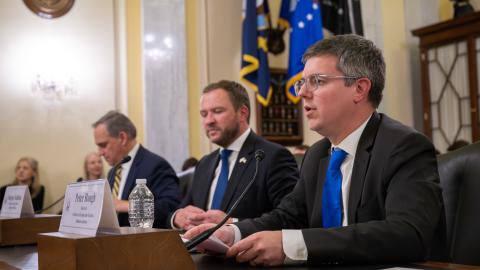U.S. and NATO officials are currently deciding what specific arms control measures they will seek regarding the remaining tactical nuclear weapons (TNW) in Europe. Although NATO officials have linked further reductions in the alliance's TNW to reciprocal Russian reductions, NATO governments have yet to propose any formal TNW negotiations with the Russian government. Specifically, they must determine what objectives to seek, what negotiating forum to use, and how to verify any agreement regarding these weapons.
When the U.S. Senate ratified the New START Treaty last December, it also enacted a resolution directing the Obama administration to begin negotiations with Russia on limiting the two countries' tactical nuclear weapons. At its November 2010 summit in Lisbon, NATO governments also confirmed the position adopted earlier that year that the alliance link any further reductions in its TNW stockpiles to changes in Russia's policies regarding its own much larger TNW arsenal. Specifically, the ministers called on Russia to eliminate many of these weapons, to relocate any remaining TNWs away from neighboring NATO countries and to make these holdings more transparent.
Unfortunately, Russian officials have not shown interest in negotiating formal limits on their TNW, which, Russian analysts argue, make valuable contributions to Russia's security. In addition to contributing to Russia's deterrent against nuclear strikes, Russia's TNWs help compensate for weaknesses in Russian conventional forces. In this respect, Russian TNW can help negate NATO's qualitative conventional advantages in the west as well as China's quantitative superiority in the east.
Tactical nuclear weapons could also help Russia overcome NATO's ballistic missile defenses through a saturation effect, by effectively doubling or tripling the potential number of Russia's nuclear-armed missiles capable of striking Western targets. Moreover, TNWs represent one of the few military categories in which Russia has a clear advantage over NATO militaries, enhancing Russia's bargaining position in certain arms control negotiations.
Finally, concerns about deterring a potential pre-emptive attack against Russia by NATO forces leads Russian military strategists to value precisely those characteristics of their TNW--their mobility and ease of concealment--that most worry arms control advocates concerned about the diversion of TNW to terrorists. In the view of Russian military commanders, uncertainty regarding the number and location of Russia's nonstrategic weapons limits the confidence of Western militaries that they can destroy them in a first strike. Such considerations weigh against proposals to consolidate Russia's TNW in a few highly secure locations, even if dispersal makes them more vulnerable to terrorists.
Given the many benefits that the Russian government derives specifically from its TNWs, Russian officials would likely require major NATO concessions to reduce or restrict them. In return for any agreement, Russian officials would probably try to extract compensating concessions from Western governments, such as restrictions on the deployment of NATO missile defenses, attack aircraft or other military forces near the Russian border. Russian officials have also said they would seek restrictions on the nuclear arsenals of other parties, especially Britain and France. Perhaps the most likely Russian goal would be to similarly constrain U.S. nonstrategic nuclear weapons based in Europe.
In terms of the TNW negotiation forum, TNW arms control could be discussed in bilateral Russia-U.S. talks devoted solely to that issue, but Moscow has always resisted that approach. Washington's NATO allies would not welcome their exclusion either, though the United States would presumably solicit their concerns as well as those of other partners--such as Asian countries concerned that Russia would simply relocate its tactical nuclear weapons to their region--as it did in the INF negotiations during the 1980s.
Discussions of TNW limitations could also be included in the New START follow-on negotiations, which would cover various issues set aside in the rush to negotiate the recently signed treaty. But that format would make it harder to address Russian objections regarding NATO's superior conventional forces in Europe, which, Moscow argues, require Russia to retain superior tactical nuclear forces pending a new CFE Treaty.
Furthermore, the European TNWs could also be dealt with as part of the NATO-Russia dialogue regarding a new European security architecture, which Moscow hopes will result in a new European Security Treaty along the lines of the draft text proposed by Russian President Dmitry Medvedev. These could occur within the framework of the NATO-Russia Council (NRC), though NATO officials in the past have not seen the NRC as an appropriate forum for TNW negotiations.
In any case, the allies would need to assess whether they can accept a persistent Russian superiority in TNWs if Moscow declines to reduce to zero. A proportionate cut in the parties' arsenals would have Russia eliminate more TNWs than the United States but still leave a numerical imbalance in Moscow's favor.
Proposals for less-than-total reductions might be more acceptable if such an agreement were treated as an interim solution and resulted in a net decrease in Russia's aggregate superiority, a more secure and transparent Russian TNW arsenal, and an effective NATO capacity to employ whatever TNW it did maintain, thereby making threats of TNW retaliation theoretically credible.
Proposed "transparency enhancements" could include declarations about the size, location and anticipated future changes in Russian or U.S./NATO TNW stockpiles. A recurring suggestion is to relocate TNW away from frontline forces by concentrating them in a specified number of distinct storage sites accessible to arms inspectors.
In contrast, a complete ban could involve a separate agreement that applied to certain regions or globally. The latter option could include extending the provisions of the bilateral INF Treaty to encompass both shorter-range missiles and additional countries.
Even if the parties are unable to secure the elimination of all NATO and Russian TNW, or if some weapons were exempt from the transparency arrangements to enhance deterrence through increased uncertainty, limited mutual TNW reductions could provide several advantages. These include decreasing the number of possible terrorist targets; reducing modernization costs; allowing NATO to remove the TNWs from countries no longer eager to base them; and demonstrating NATO and Russian commitment to making progress toward nuclear nonproliferation.
Whatever the terms of any settlement, its verification would prove extremely difficult since both the attack aircraft that NATO uses as its main delivery system for nonstrategic nuclear weapons and the short-range missiles that Russia favors for TNW use are typically dual-use systems that can also launch conventional strikes.
The most ambitious proposals would seek high transparency levels through comprehensive verification and monitoring of TNW arsenals by means of extensive data exchanges and on-site inspections. But such plans run against the recent trend of Russia and the United States seeking to reduce verification obligations in order to limit implementation costs of arms control treaties.
More importantly, any proposals for increased transparency or TNW consolidation would need to overcome Russian fears about NATO pre-emption, since placing the weapons in a few designated places would make them easier to attack, creating opportunities--and incentives--for a pre-emptive first strike aimed at destroying the weapons before they could be dispersed to their launch sites.
The complex and interlocking barriers to reaching an agreement converge toward a simpler but persistent obstacle: Securing deep cuts in Russia's TNW arsenal, as well as resolving the related dispute between Russia and NATO over U.S. missile defenses, might not be possible until the underlying causes of Russian concerns--fears of a NATO attack--considerably decrease.













